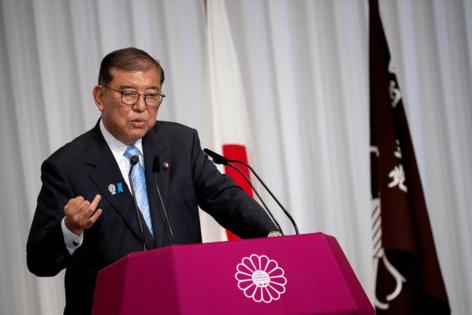Japan's Ishiba tries to buy time after historic election setback
Published in Political News
Japanese Prime Minister Shigeru Ishiba sought to buy time in office following a second election setback in less than a year. But whether he stays days, weeks or even months, Sunday’s vote made clear that his Liberal Democratic Party needs an overhaul to stay relevant.
Ishiba on Monday vowed to remain in his job even though his LDP-led coalition finished Sunday running a government without a majority in both chambers of parliament for the first time since the party’s founding seven decades ago. While it has ruled Japan for most of that period, younger voters are increasingly turning toward populist smaller parties as rising prices fuel discontent.
“The LDP is a fatigued party and it has a brand problem,” said David Boling, director at the Eurasia Group covering Japan and Asia Trade, former negotiator at the USTR. “To be blunt I think many Japanese and many Japanese voters see it as a party of old men who are out of touch.”
Although the outcome on Sunday wasn’t as bad as some of the early exit polls suggested, Ishiba still failed to clear the low bar he set of retaining a majority in the upper house. That leaves him at risk of becoming yet another footnote in the revolving door of Japanese prime ministers that only managed to last for a year or so.
For now, Ishiba can lean into the fact that he needs to stay on to negotiate a trade deal with the U.S. to help Japan avoid a steep increase in tariffs from Donald Trump’s administration. He cited those talks and other pressing issues at his briefing on Monday.
“I plan to put all of my efforts into finding a solution to the urgent issues we face, including the U.S. tariffs, inflation, natural disasters, and the most complex and severe security environment since the war,” Ishiba said.
Still, it looks like his days are numbered — even if he has no obvious successor right now.
“We’ll see in the next day or two if the dissenters are able to gather enough people to push him out, but this can’t go on,” said Tobias Harris, founder of Japan Foresight, adding that none of the opposition parties want to join a coalition with him. “It all looks like you’ve got a political crisis.”
Harris cited four key points a replacement would need for success: bringing back right-wing voters, appealing to a younger demographic, matching Trump at the negotiation table and rebuilding a governing coalition that can win at the ballot box. Few of the familiar names in the LDP check all four boxes, he said.
The timing of any move may depend on the success of the trade talks.
Ishiba said he wanted to speak with Trump and obtain tangible results in the negotiations soon. His long-time right-hand man Ryosei Akazawa is already on his way to Washington for an eighth attempt to gain traction with his counterparts in the U.S.
Among the key sticking points is the sectoral tariff on cars and auto parts that is sending profit hit shockwaves through Japan’s auto sector. Within the LDP there is already unhappiness about Ishiba’s relatively neutral response to Trump’s abrupt letter stipulating higher across-the-board duties of 25% from the beginning of August.
“If Ishiba has no concrete results by then the voices calling for his resignation will likely get louder,” said Katsuyuki Yakushiji, professor emeritus at Toyo University and writer of multiple books on Japanese politics. He indicated that August would likely be the make-or-break month for the prime minister.
The last three LDP prime ministers who lost an upper house majority stepped down within two months, including Shinzo Abe in 2007 during his first stint as premier. Abe’s departure then, may provide a rough time frame for Ishiba now. Abe lost the majority in July, tried a cabinet reshuffle in August to regain momentum then stepped down in September. That month is a common post-summer timing for the LDP to appoint and try to rally around a new leader.
At the time, Ishiba was one of the LDP’s fiercest voices calling on Abe to resign unless he could justify a reason for staying on. Ishiba was reminded of this comment on Monday and said he clearly remembered asking Abe to explain himself to the public as well as the party.
Fast forward 18 years and it’s Ishiba taking the heat. The same names in the news, a generation later.
The opposition gains in the election show voters are wanting something different. Ishiba is the leader the LDP chose, but he’s not the choice of most members of the public. And they seek a sales tax cut to ease the pain of inflation they never asked for either.
While the Constitutional Democratic Party came second as the biggest opposition party offering to address the tax issue, many younger voters opted for the Democratic Party for the People’s and its pledge of more take-home pay for working age people.
Harder conservatives drifted to Sanseito and its “Japanese First” message, though support remained highly localized around areas with high concentrations of foreigners or as a kind of protest vote in the proportional representation segment of the election.
Former Prime Minister Fumio Kishida is among the LDP members who might check a couple of the check boxes cited by Harris, while Sanae Takaichi, the policy hawk who lost out to Ishiba in last year’s party shootout, might seem an obvious choice to win back right-wingers. But both would give the impression of looking at the rear-view mirror. Takaichi would likely more look like Abenomics II, than a move forward.
Instead the party should look at younger guns such as conservative former Economic Security Minister Takayuki Kobayashi or Shinjiro Koizumi, the “rice minister” whose quick action has helped cool prices of the nation’s staple, according to Eurasia’s Boling.
In Koizumi’s case, he also inherits some reformist cache from his father Junichiro, a party maverick who helped re-brand the party a quarter century ago, something the party needs to do again now.
“I think that brand needs to be a face of a younger LDP member. Is that Kobayashi? Is that Koizumi?” said Boling. “I think it’s probably more Koizumi than Kobayashi.”
---------
—With assistance from Yuko Takeo.
©2025 Bloomberg L.P. Visit bloomberg.com. Distributed by Tribune Content Agency, LLC.

























































Comments